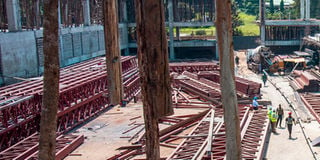Inflation slams brakes on construction sector

Workers at a construction site in Munyonyo, Kampala. The rising costs of construction and building materials in Uganda have forced Ugandans to stretch their budgets significantly in order to rent or buy a home. PHOTO | MICHAEL KAKUMIRIZI
What you need to know:
- The high fuel prices have been identified as the main driver of energy inflation, according to economists.
The rising costs of construction and building materials in Uganda have forced Ugandans to stretch their budgets significantly in order to rent or buy a home.
Data from the Uganda Bureau of Statistics (Ubos) shows that the rate at which costs increase in the construction sector rose by 0.2 percent in August compared to 0.1 percent the month prior.
“Specifically, demolition and site preparation inflation increased by 0.5 percent in August compared to 0.1 percent decrease registered in July,” Ubos noted in a statement.
Additionally, the high cost of civil engineering structure establishments exacerbated the monthly change in building material prices, affecting primarily the construction of residential buildings. Most notable were the increments in the price of diesel, iron, steel or aluminium plates, adhesives and seals and nails, bolts, and screws.
However, electrical, plumbing and other construction activities inflation decreased by 0.3 percent in August compared to 0.7 percent decrease registered in July.
“Supply chain disruptions caused by the Ukraine war, which delayed delivery of inputs to local industries, combined with an increase in fuel prices, which has exacerbated logistic expenses for our local manufacturing companies, have largely affected the price of these construction input materials,” said Mr Martin Kyeyune, a Ugandan construction economist.
The situation has gotten worse due to the construction industry’s declining investment returns, which have made it even less appealing to financial institutions for credit. The Covid-19 pandemic’s impact on economic activity was largely responsible for the outcome in 2020 as consumer spending and business output were both hampered by lockdowns.
Data from the Bank of Uganda (BoU) reveals that the construction sector has experienced low revenue growth for the last four years in a row, going from about $1 billion to $500 million in 2021. A number of commercial banks are consequently reluctant to lend to an industry whose returns are long-term.
“The tightening in the building, mortgage and real estate sector was mainly attributed to the low property rates and decreasing occupancy levels,” BoU noted in the fourth quarter of the 2022/2023 financial year Bank Lending Survey Report
“Returns in the real estate sector are long-term, whereas banks rely on short-term deposits,” Mr Kyeyune said.
Low sales
Industry players such as Hima Cement Ltd reported low sales volumes in 2022 as a result of global inflationary pressures and supply chain disruptions, which have harmed many manufacturers who rely on imports for inputs. According to Bamburi Cement Ltd, the parent company of Hima Cement, “the decline in sales volumes and turnover is primarily due to a decrease in government infrastructure project spend, suppressed consumer purchasing power, and stunted private sector credit growth, which was exacerbated by market contraction experienced in the month of May due to Kenya’s general elections.”
Energy and power costs are the biggest cost components in the production and distribution of construction input products. “This has led to inflation of prices of imported raw materials and energy costs, especially on coal thus eroding the margins,” Bamburi Cement noted.
Inflationary pressures
When the inflation rate rises, the price of building materials rises as well. Clients not only account for the rise in construction costs but also pay a surcharge on construction prices due to the vagueness of inflation.
“Not only material prices, but also labour wages are affected by inflation, which has had an impact on the final project cost. To address the cost overrun problem, it is necessary to develop a technique for formulating the budget at the start of the project by considering the inflation aspect before finalising the budget estimation,” a 2023 Ain Shams Engineering journal on the impact of inflation rate on construction projects budget, notes.
The government is aware of the inflationary pressures that are affecting the manufacturing industry and is combating them by freezing the Central Bank rate at 9.5 percent.
To save the vulnerable sector, investors in the construction, building, and manufacturing sectors are borrowing overseas at low interest rates in order to achieve competitive returns on investment.
BoU policy statement
The BoU stated in its October 2023 Monetary Policy Statement that annual inflation has continued to moderate despite these recent increases in fuel prices. This is due to the implementation of appropriate monetary and fiscal policies, the waning impact of the drought on food prices, and the easing of global cost pressures.
From 3.5 percent and 3.3 percent in August 2023, the annual headline and core inflation rates fell to 2.7 percent and 2.4 percent, respectively, in September 2023.
The World Bank Group has even supported the BoU’s decision to hold off on tightening monetary policy in light of the country’s easing inflationary pressures.
“At the sub-regional level, inflationary pressures are receding in most East and Southern African countries- and in some cases, they are within or close to medium-term targets for instance; Kenya, South Africa, and Uganda. It is likely that these countries may pause their hiking cycle, while others may need to continue to fine-tune policy to reduce inflation further,” the World Bank stated in its revised sub-Saharan economic outlook report, published last week.




